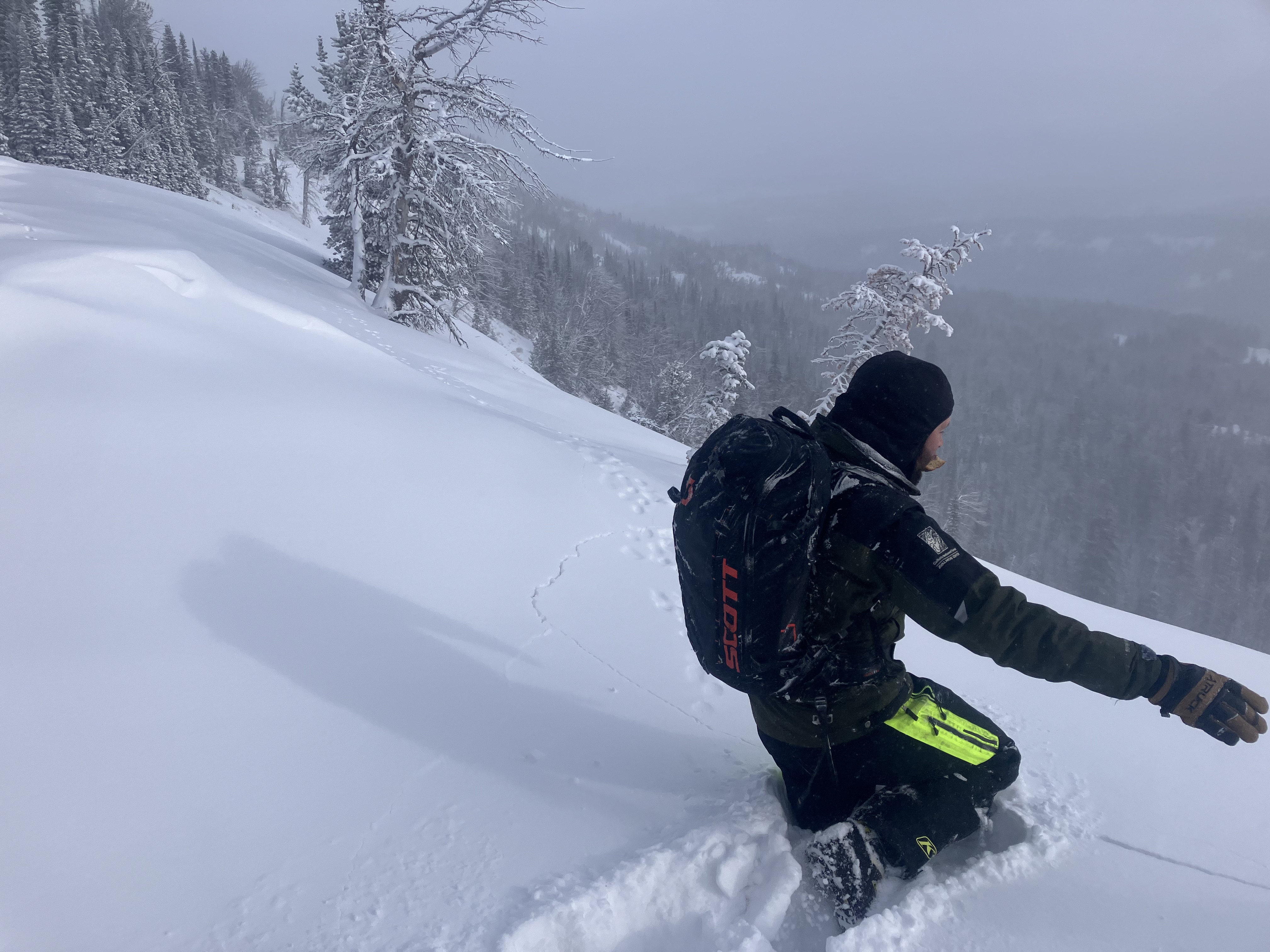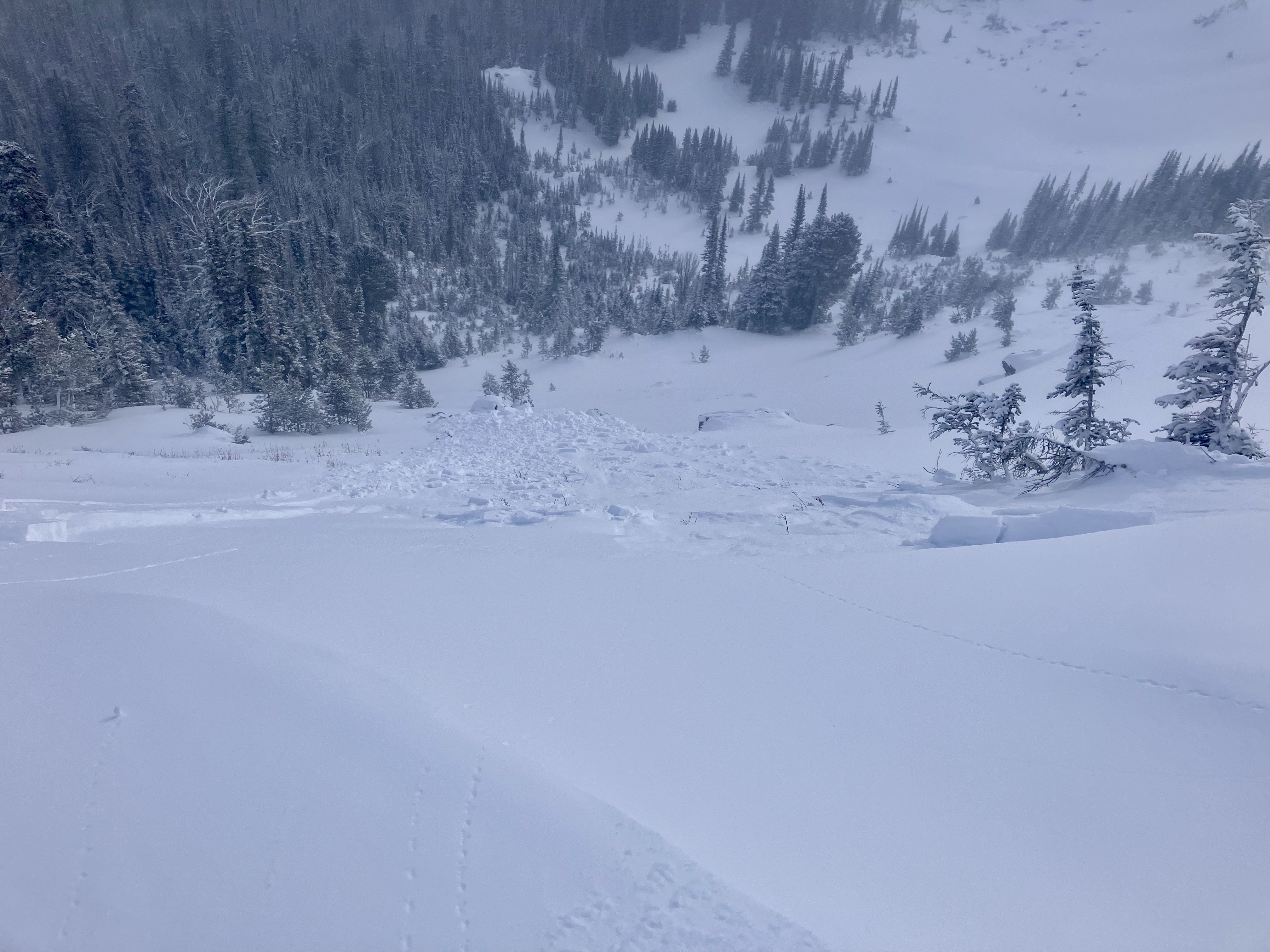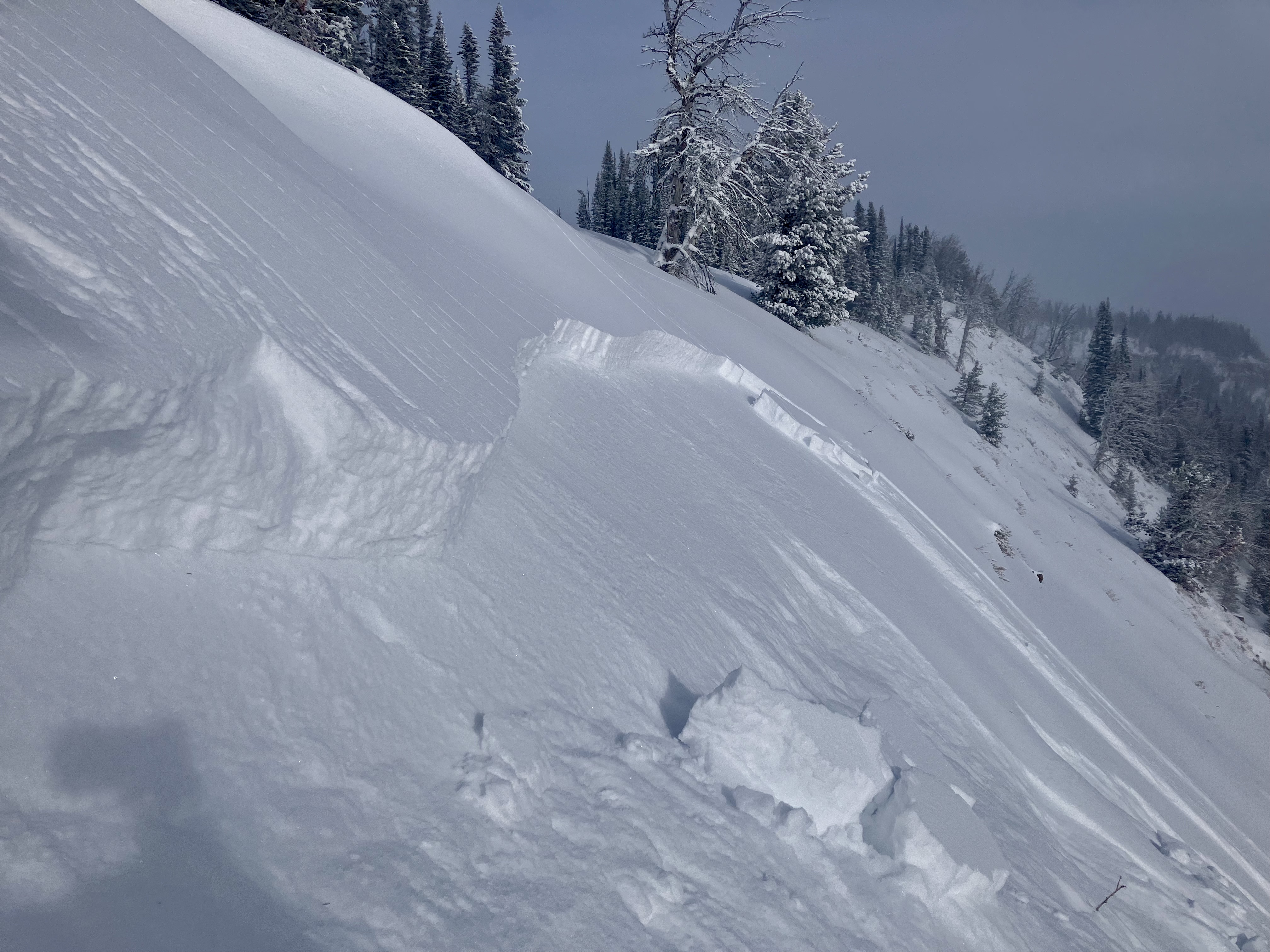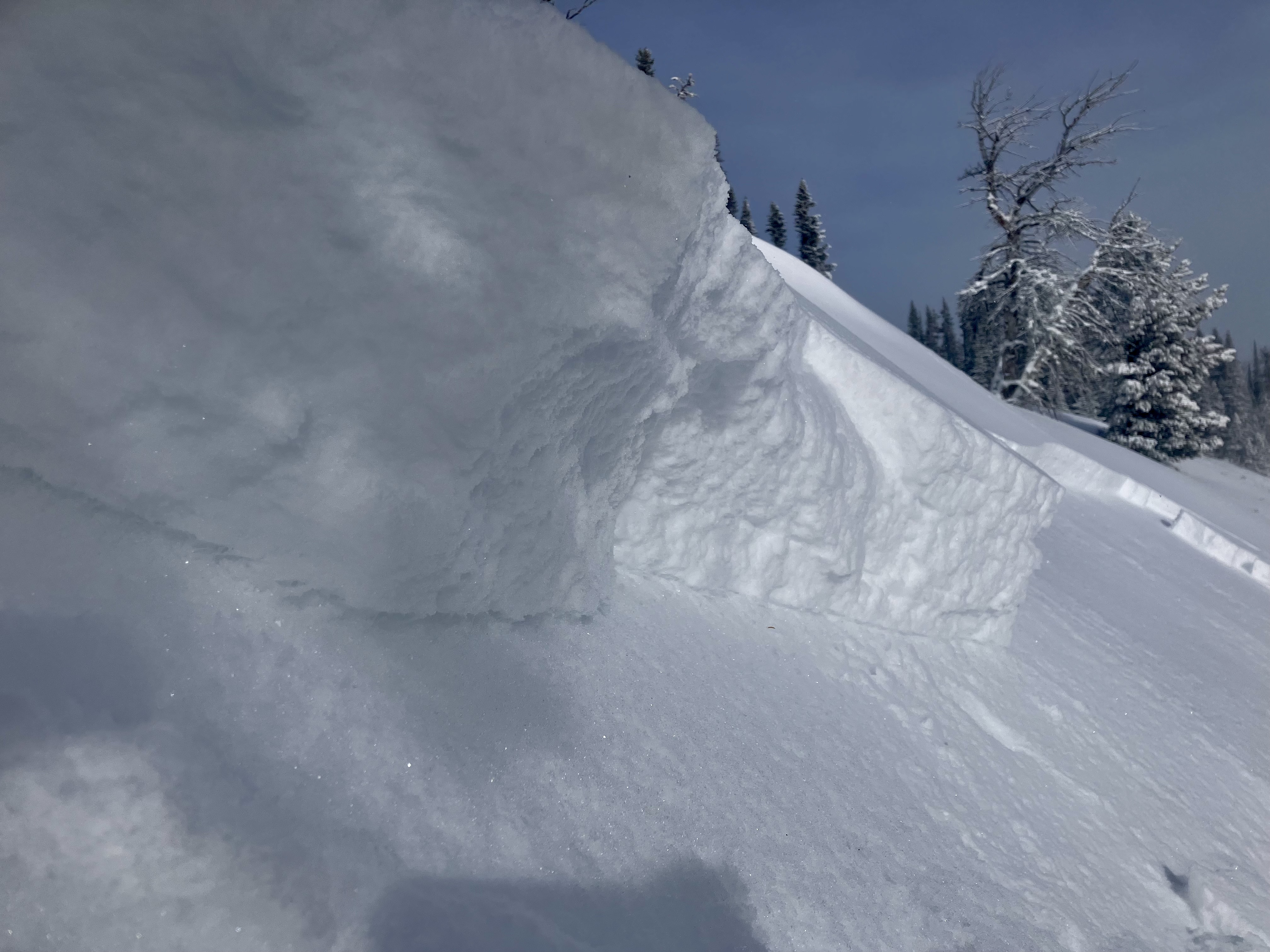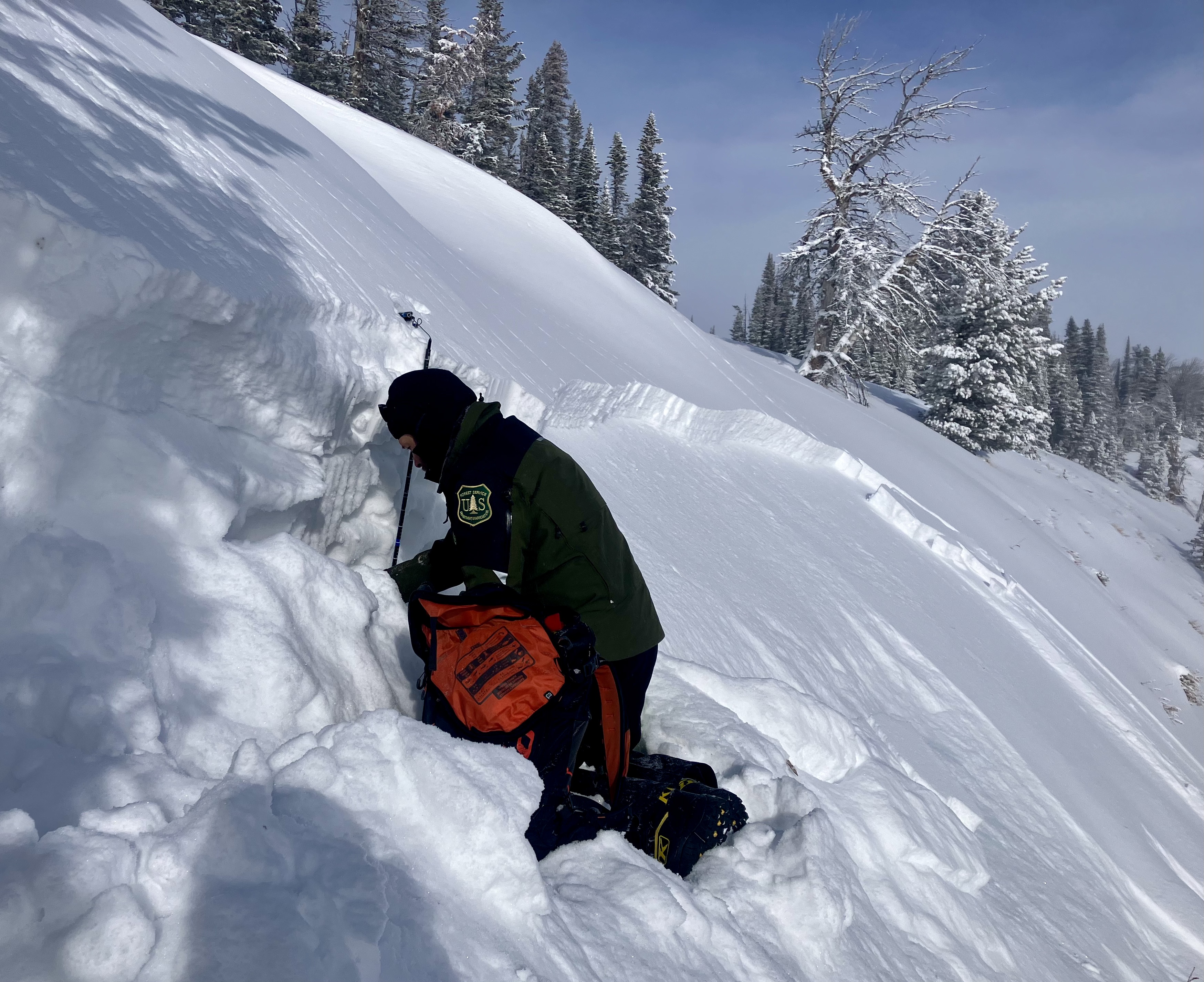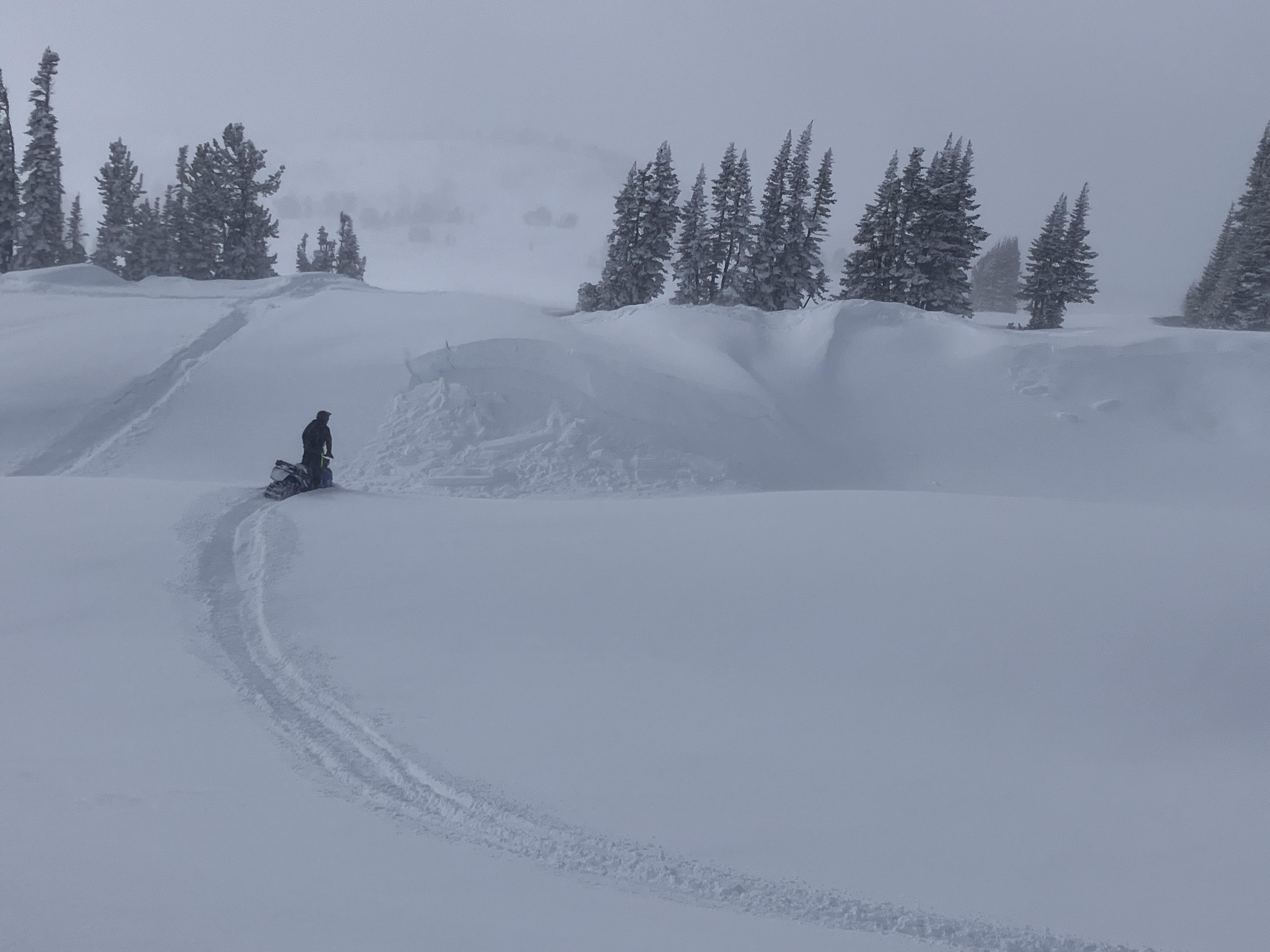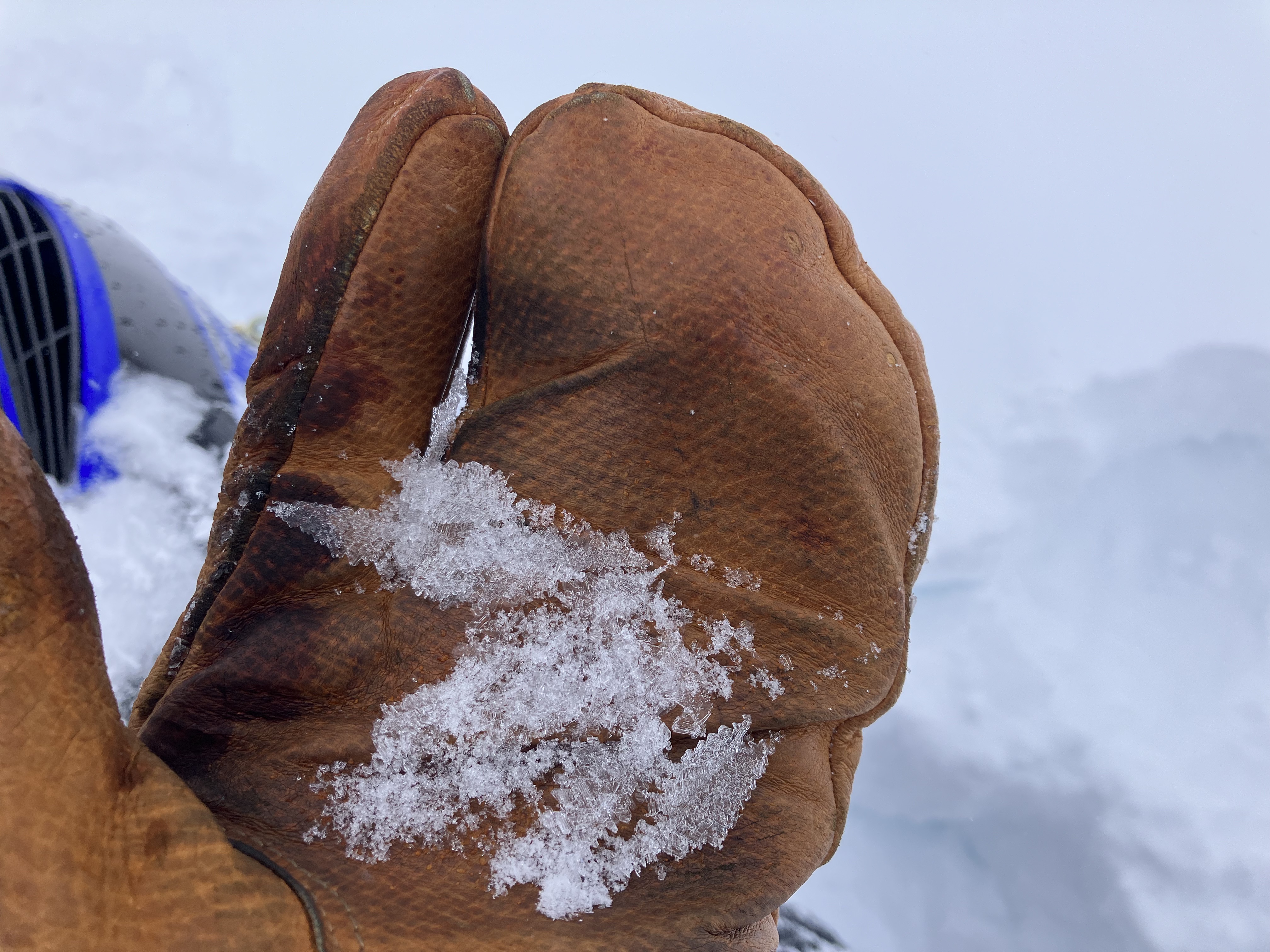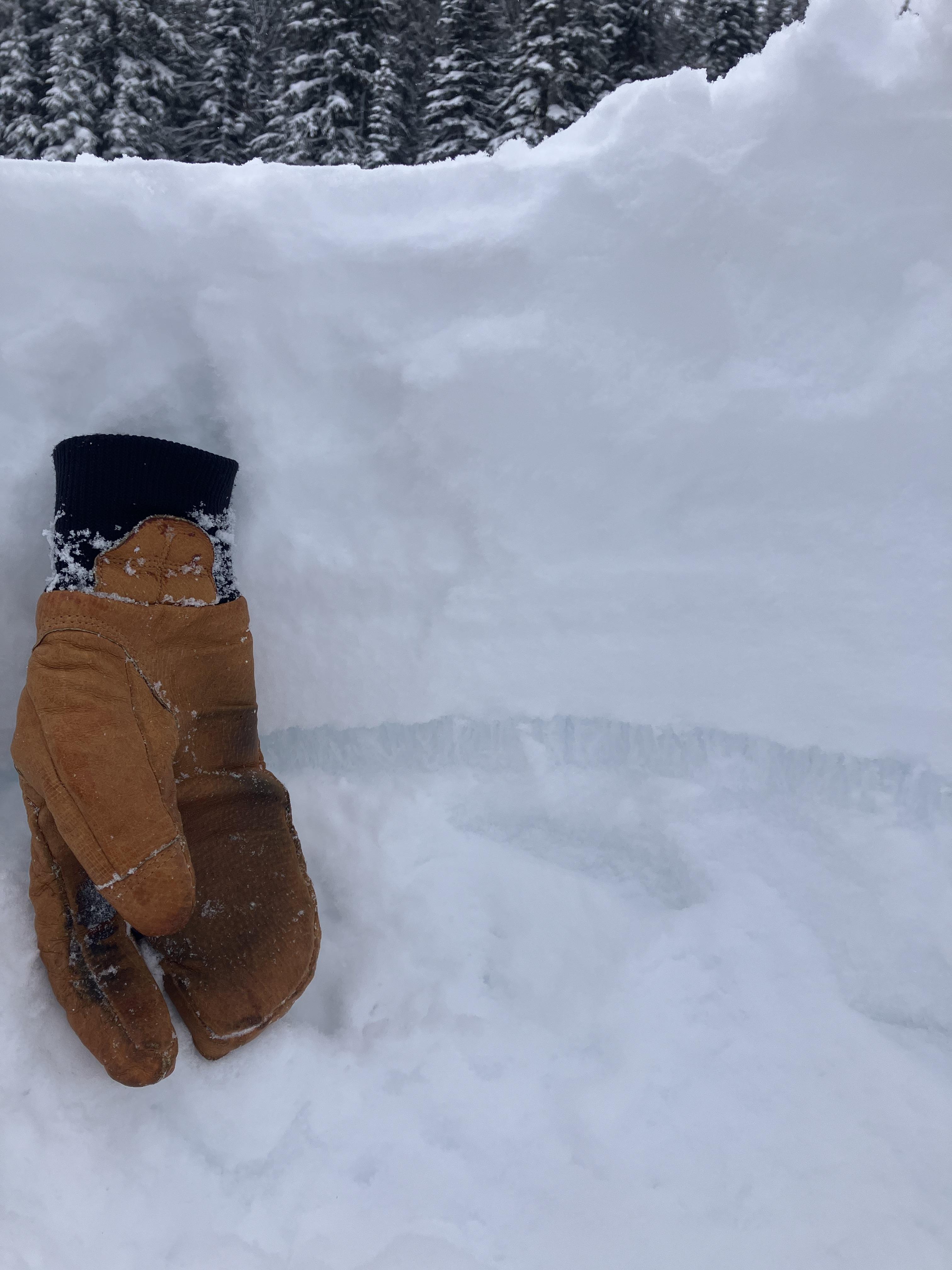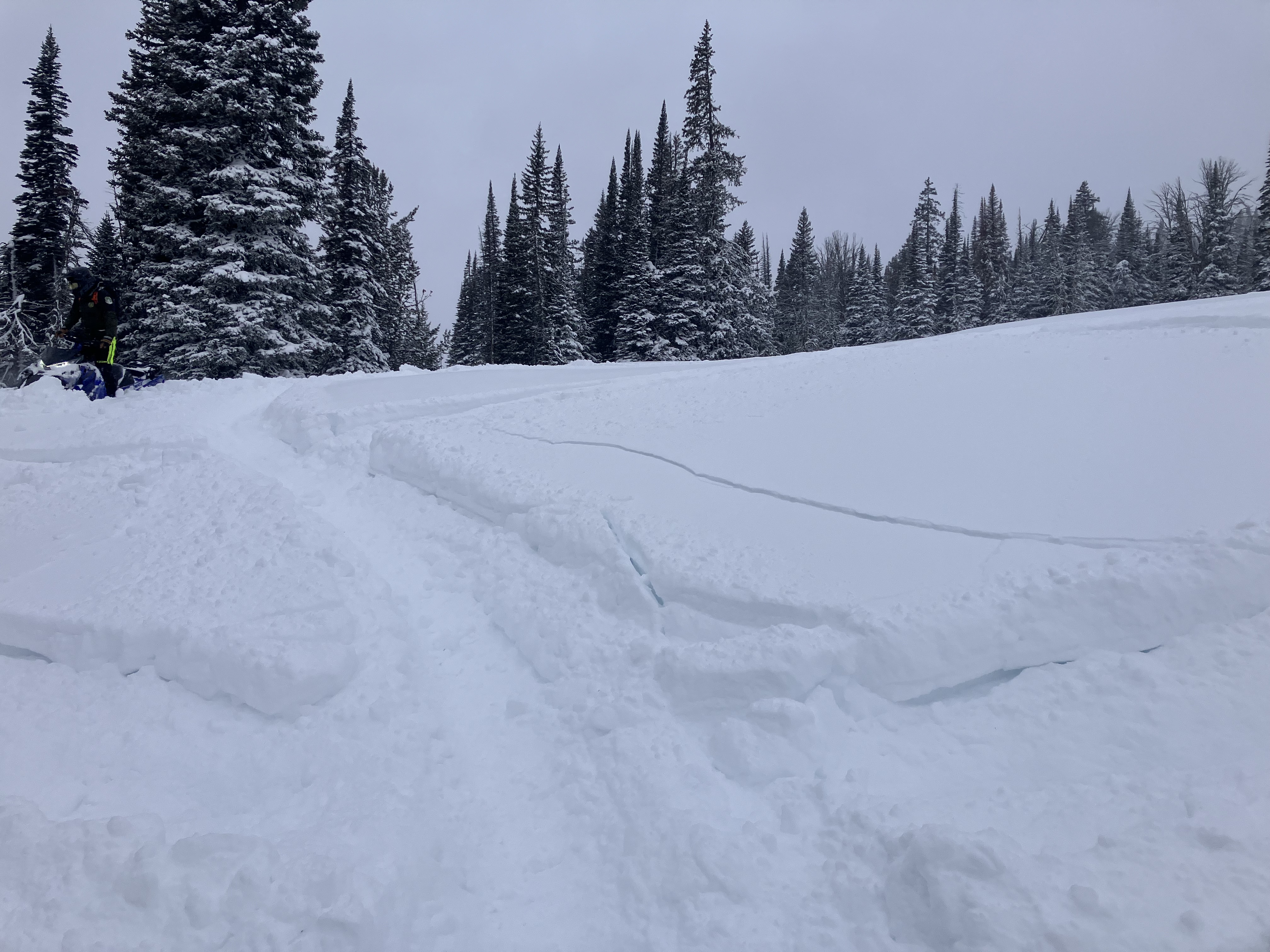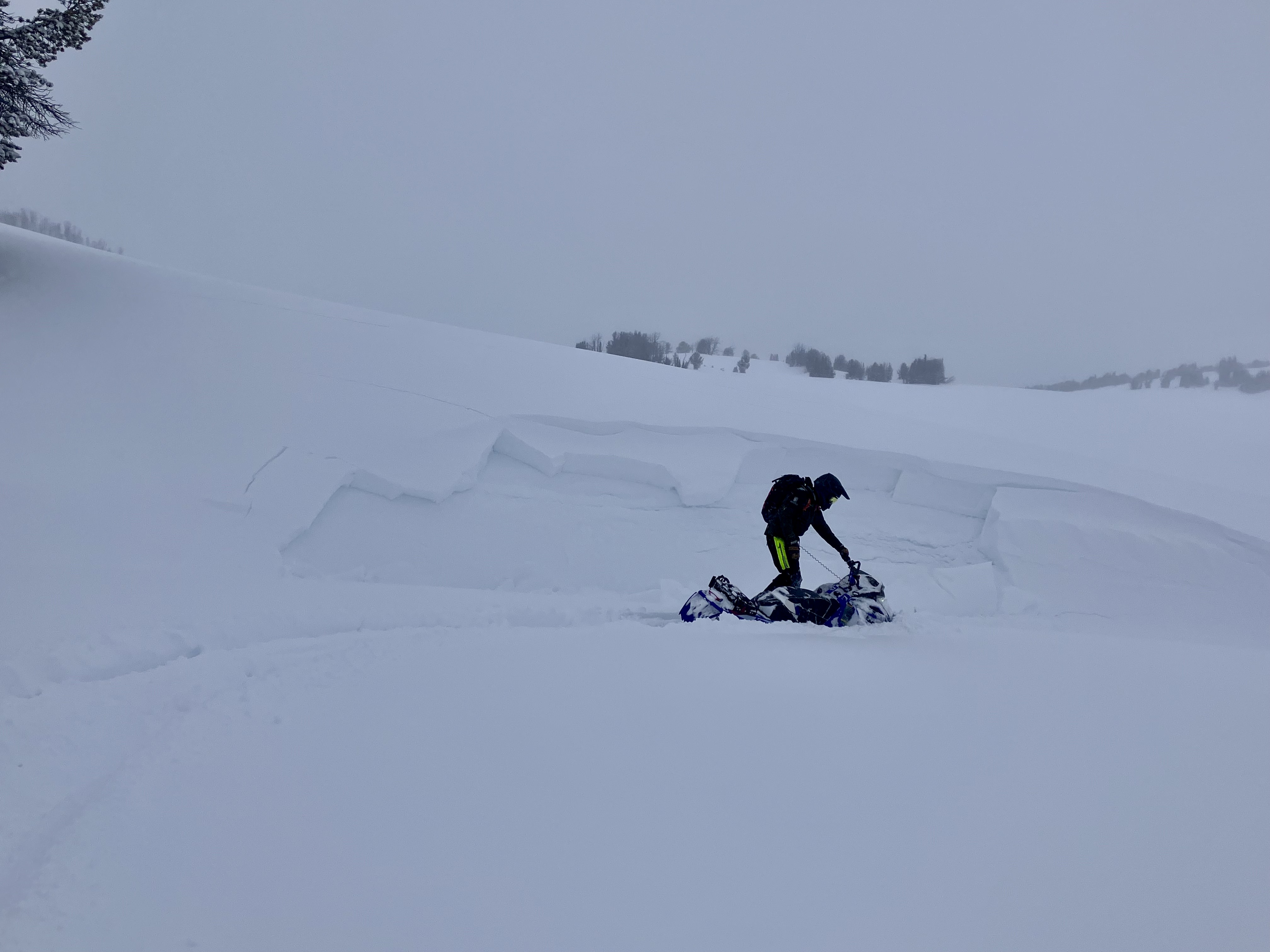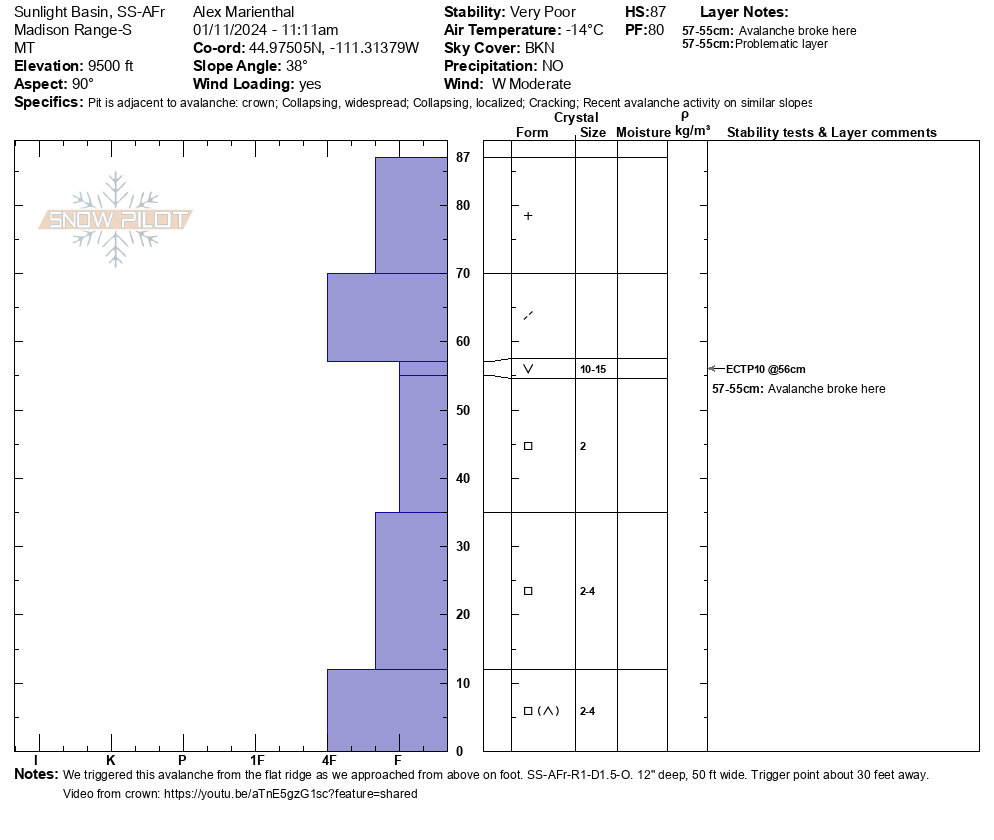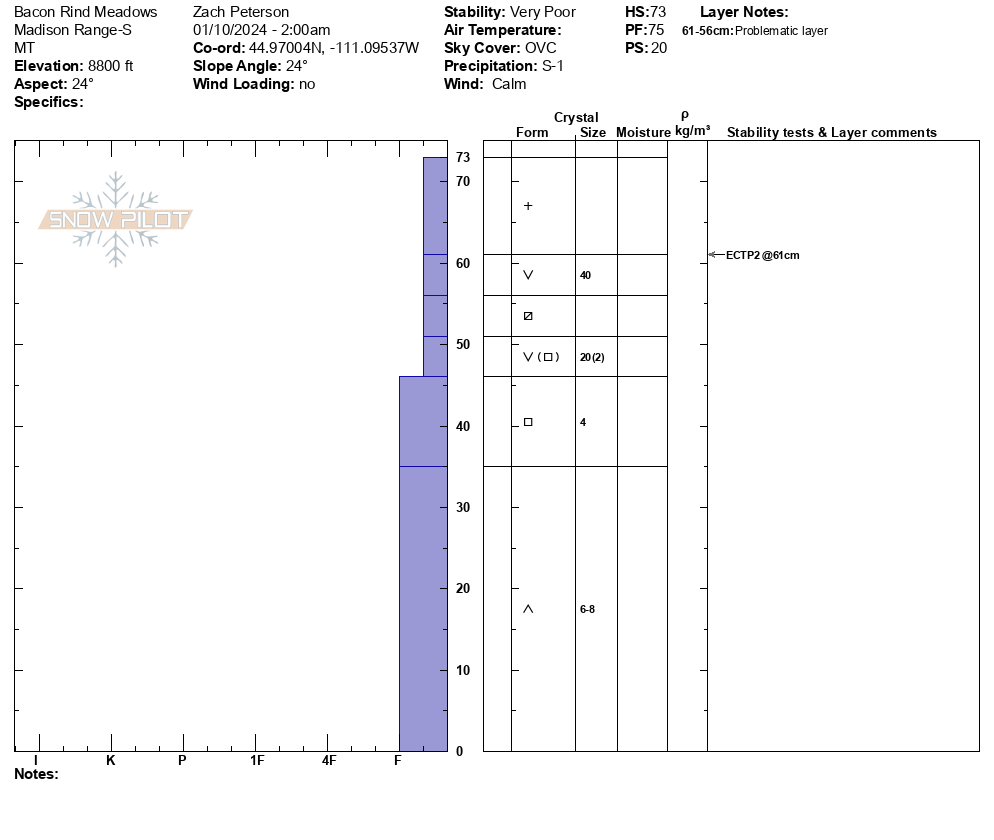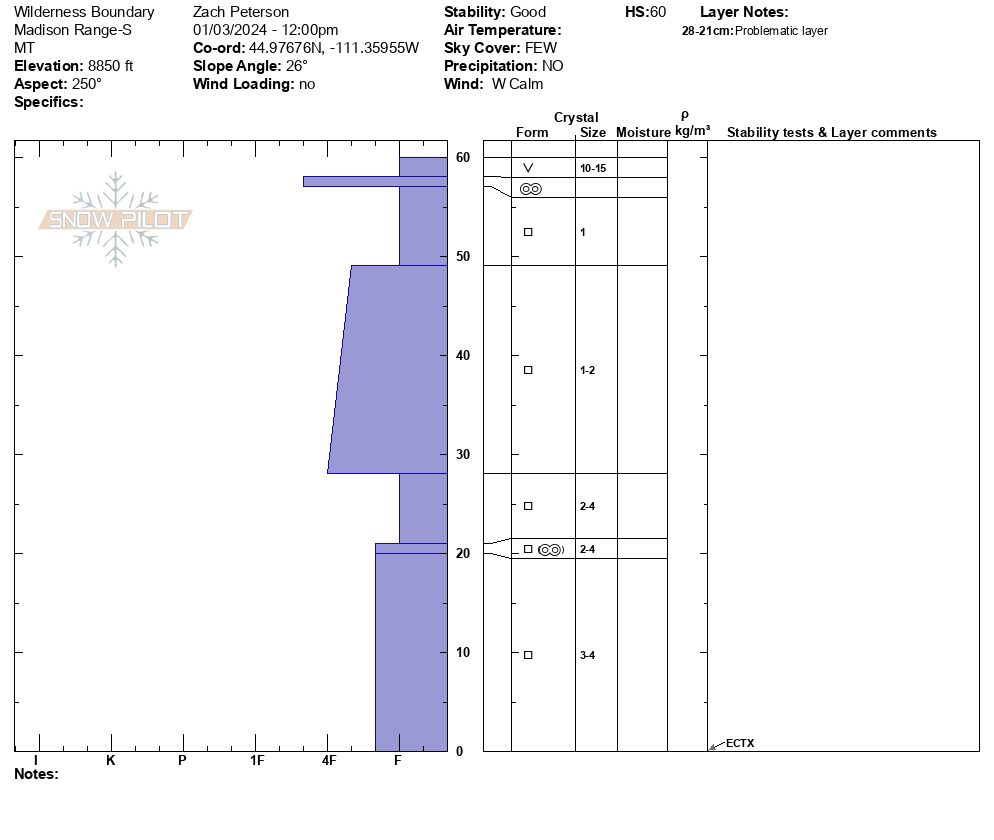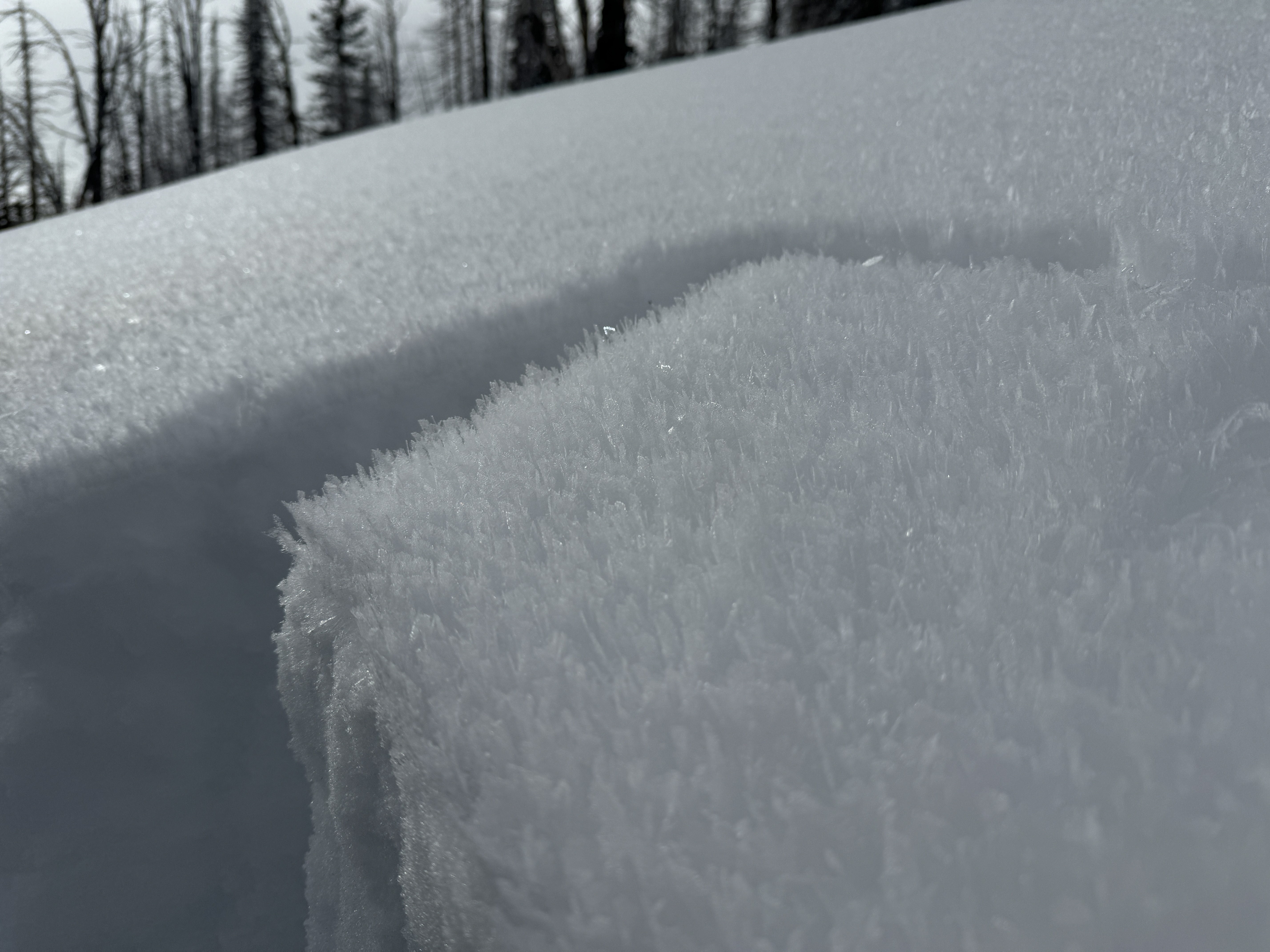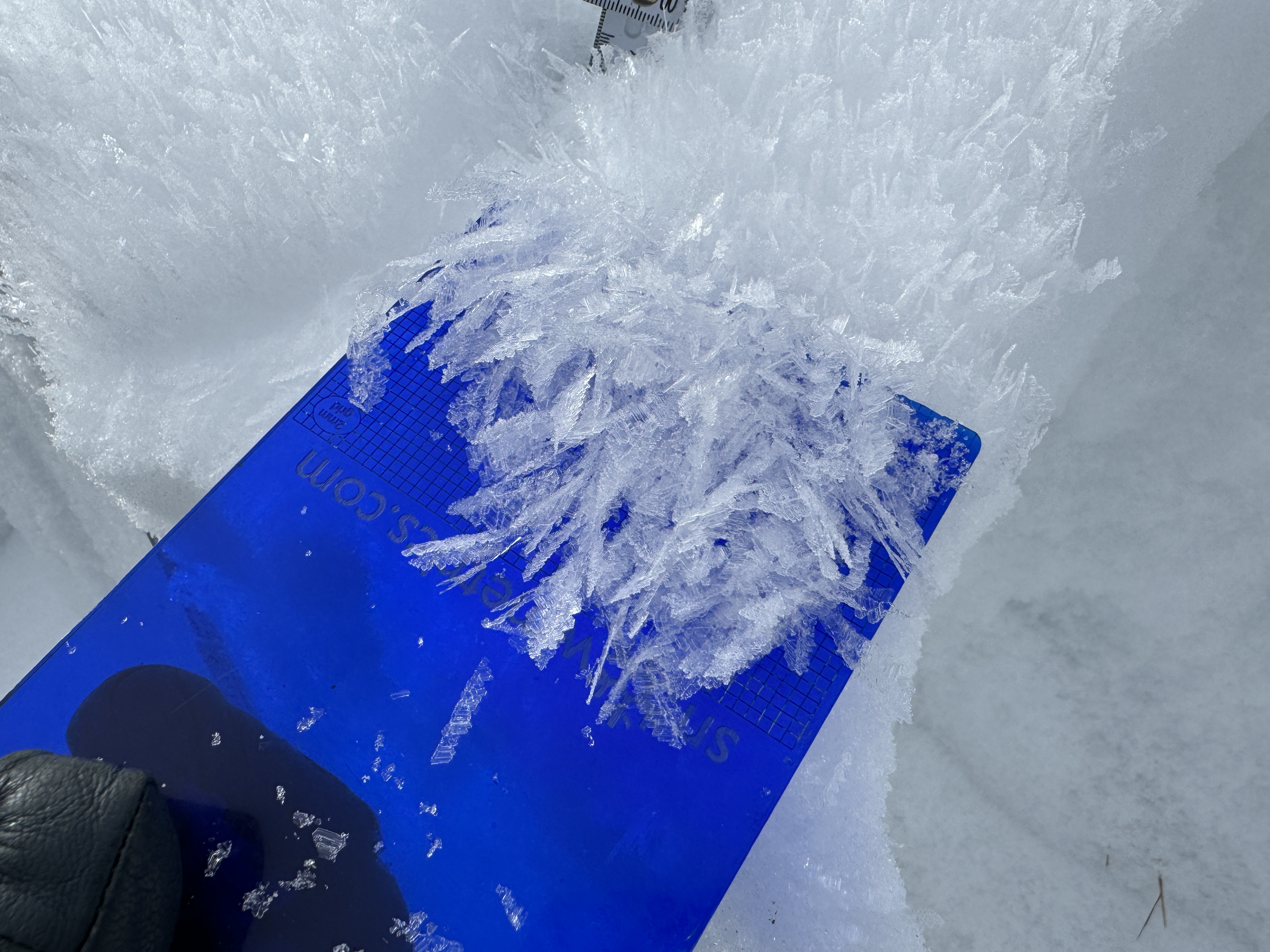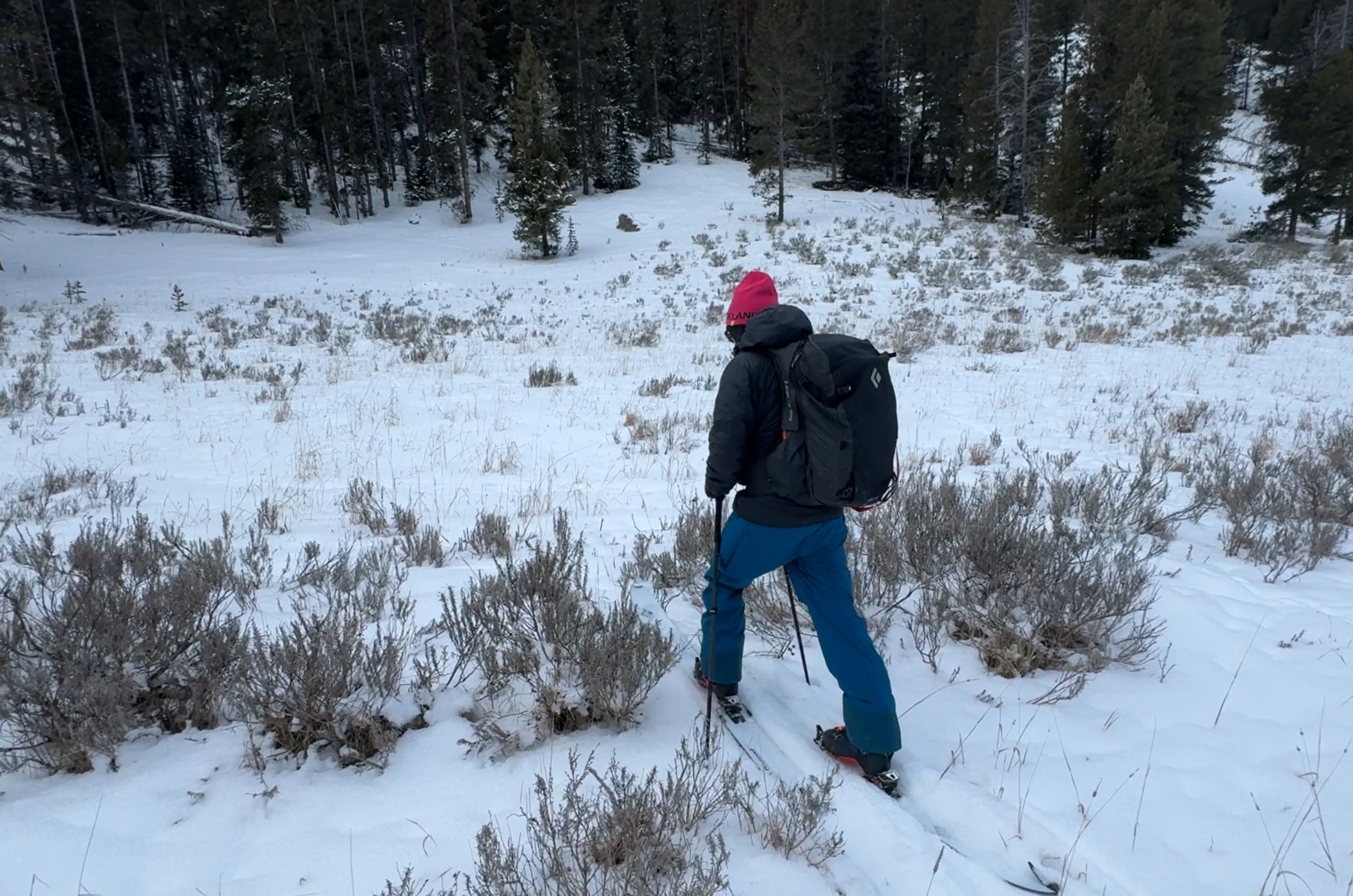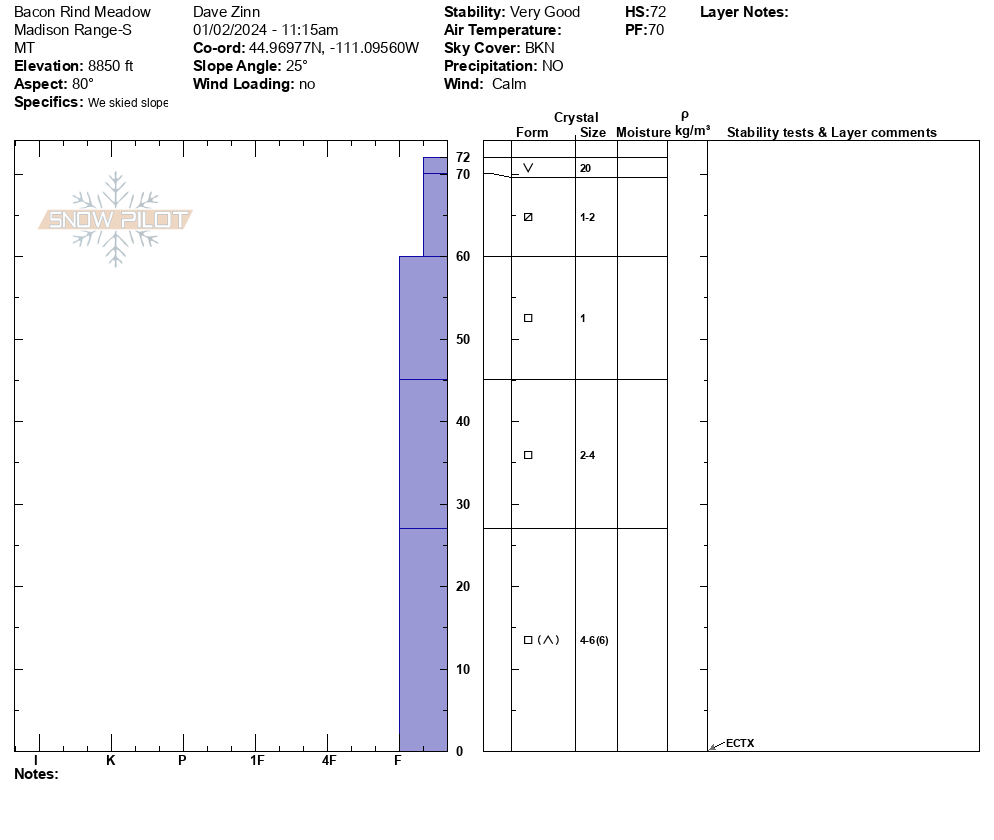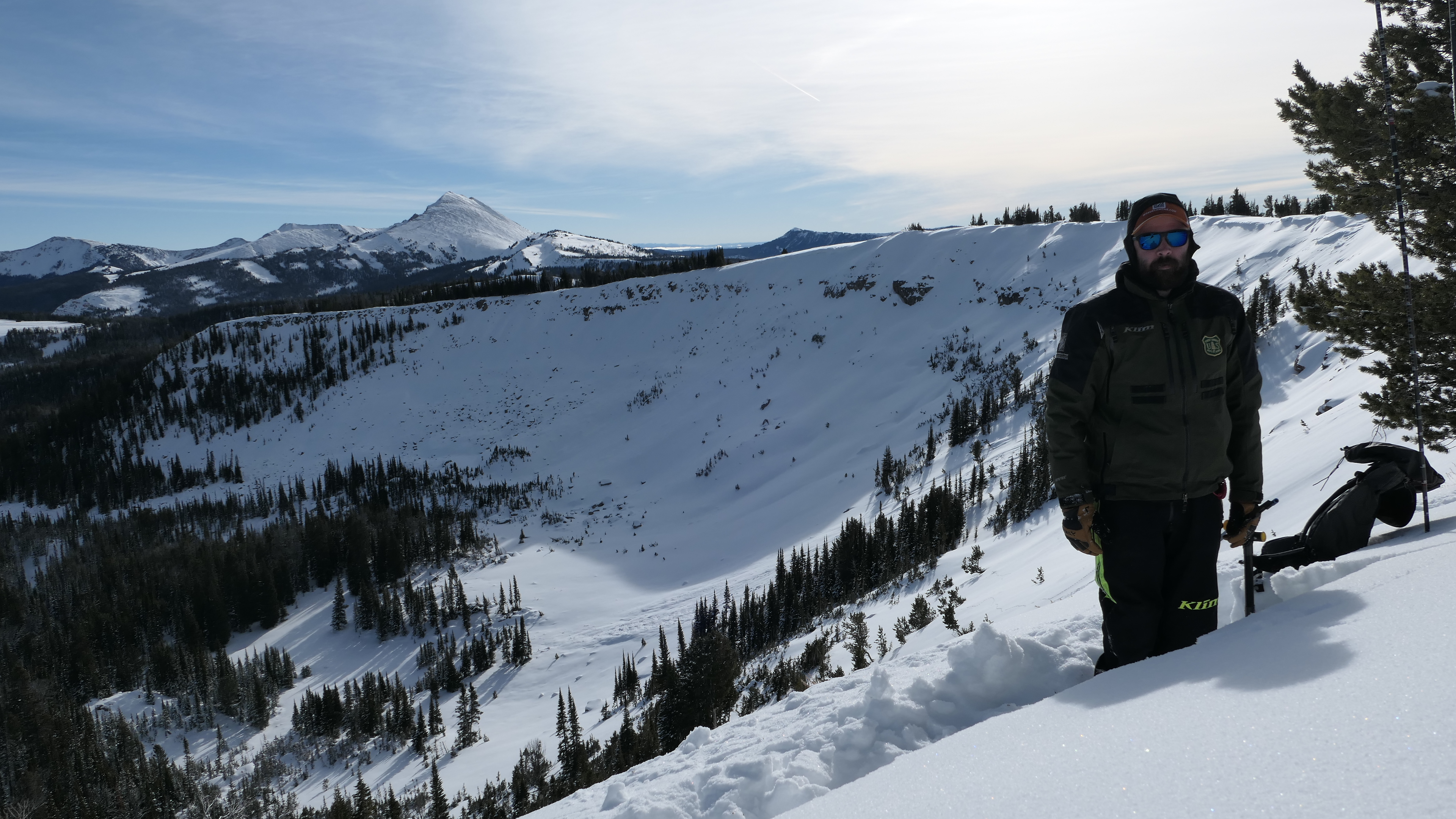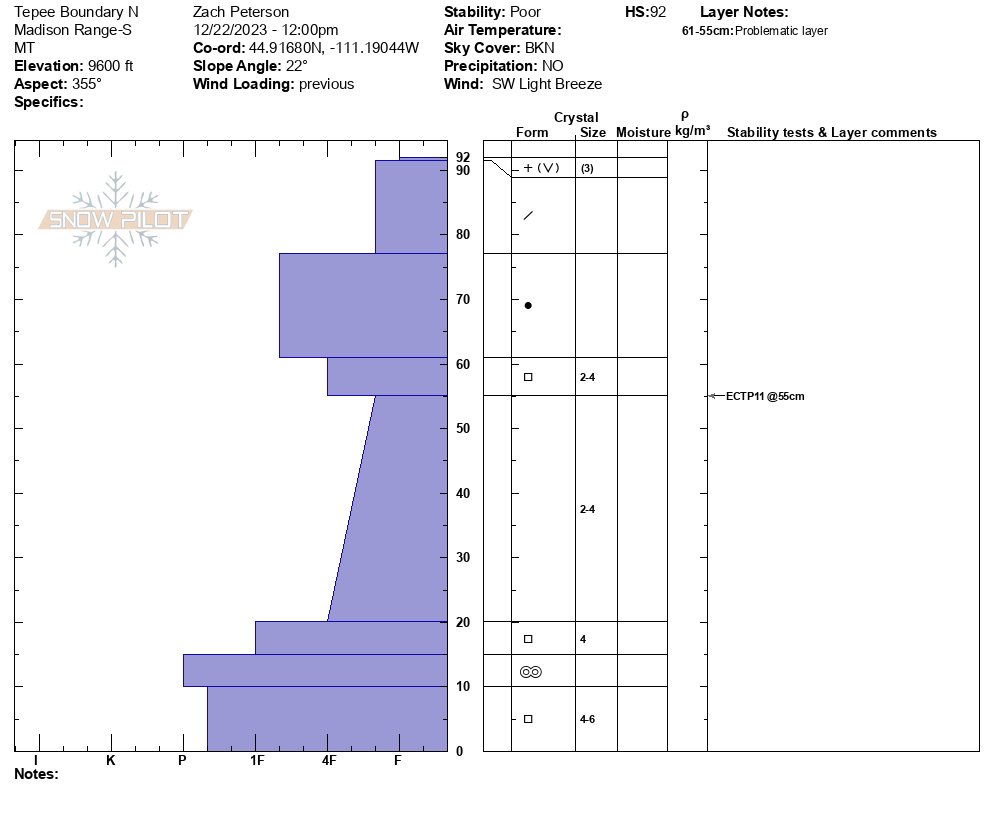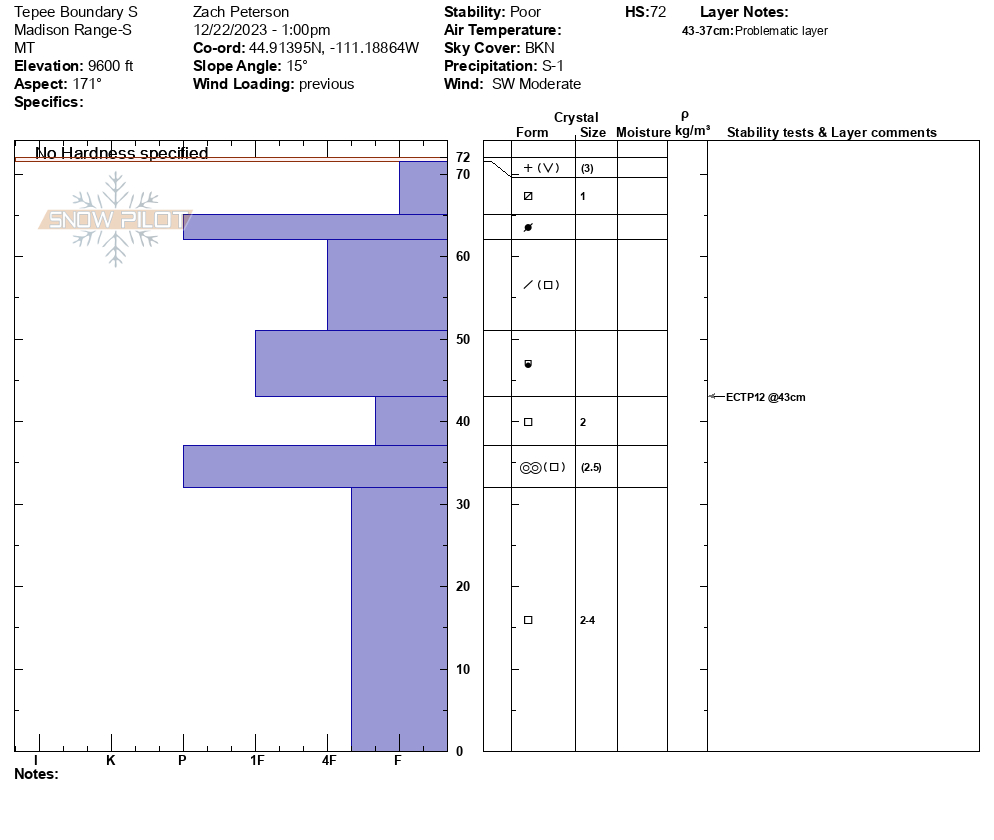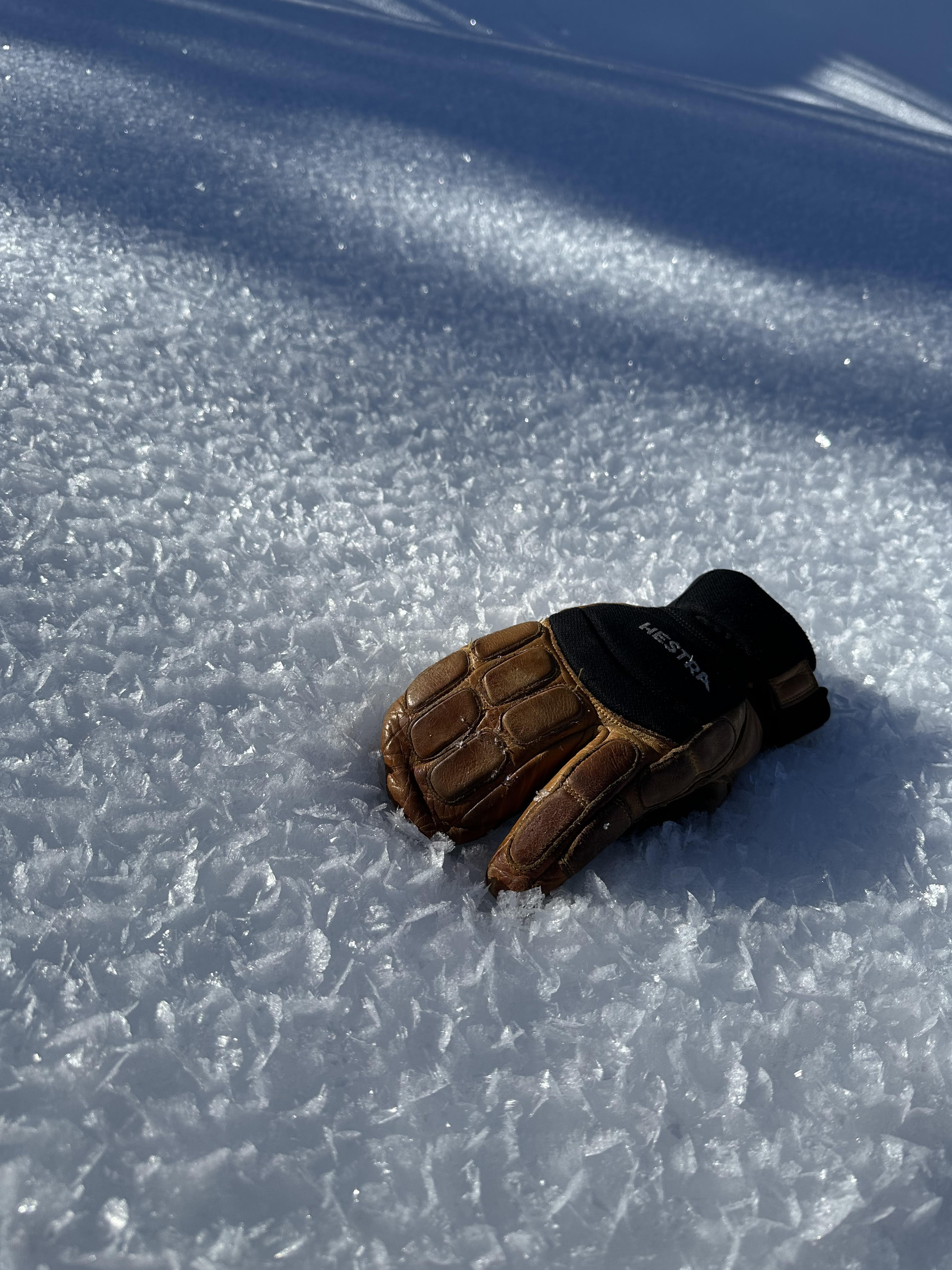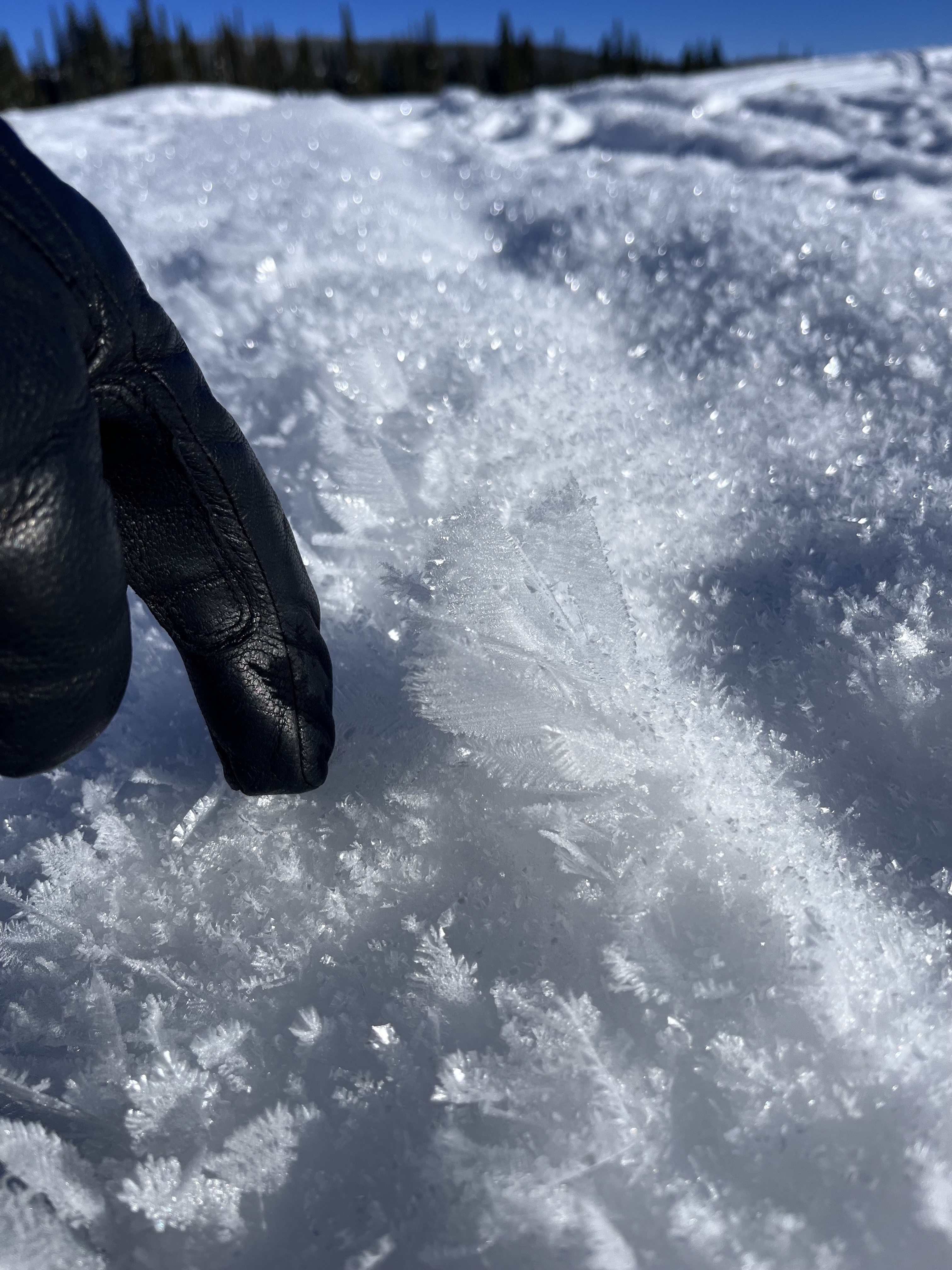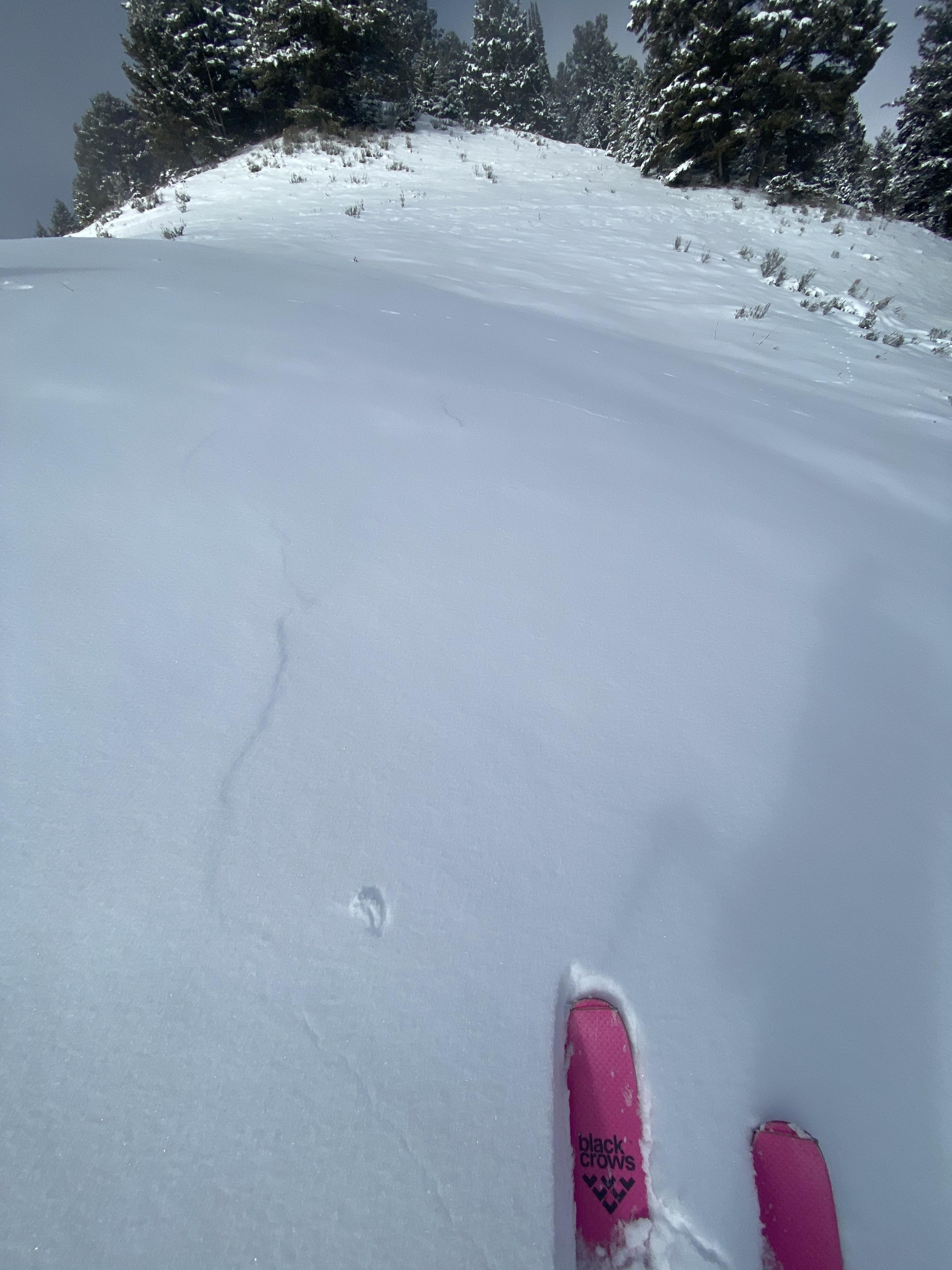Snow Observations List
Went for a short tour near bacon rind, next pulloff to the south, toured up the burned out hill right across the street. It was real windy leaving my vehicle. Some notable whoomphing, and cracks forming 30 ft around me. I probably won’t be riding down there for a bit, the low angle stuff I like is too thin. Real thin down there with only about 40-60cm on the ground. Got a CT1 SC Q2 breaking about middle of snowpack, ectn 2, and ectp24.
Full Snow Observation ReportFrom FB: Taylor’s Fork today, 8-10 inches of new snow last night. A few small slides but tons of cracking.
Full Snow Observation ReportFrom FB
ECT failed at 9 at most recent layer of facets, 50cm above ground level, 15cm thick, approaching ball bearing consistency.
East facing slope, 7848’
Total snow depth 75 cm
Hard slab between 35-50cm, second facet layer at 25cm, consolidated to ground, couldn't get either the middle slab or lower facet layers to fail.
Some cracking while we skied out.
On 1/12/24, a skier triggered a 2 ft deep avalanche on a wind loaded south facing slope at 9700 ft near Big Sky and was caught and carried by it.
Full Snow Observation ReportFrom facebook message: "Strong winds and heavy wind loading. Cabin creek below skyline ridge. 1/12/24. Was seeing Shooting cracks all day."
Full Snow Observation ReportWe saw a lot of action (unstable snowpack) in Taylor Fork today. At Sunlight Basin, we remotely triggered an avalanche while walking on the flat ridge above a wind-loaded slope. The avalanche broke below a 12" deep slab with 1.5" of snow water equivalent in the slab, and it failed on a layer of large (1-1.5cm) surface hoar. Video, pics, and crown profile attached. We also saw a small wind loaded slope that was triggered (remotely) by riders yesterday, and we triggered a similar slope today. These were short slopes, but the slabs broke over 1 foot deep and as wide as the terrain feature, and they were triggered from adjacent flat terrain 10-40 feet away (remotely triggered).
While riding around we frequently saw large shooting cracks on any slope with a slight wind-load/wind-effect. Near the wilderness boundary we saw these large cracks across the snow surface. In quick hand pits we easily found a weak layer of surface hoar below the recent snow that was 3-4cm long crystals, standing upright!!! (pics attached).
Wind was moderate out of the west, actively loading slopes and filling in tracks all day. Mostly cloudy/partly sunny morning. Started snowing in carrot basin around 1pm, shortly before we left.
Full Snow Observation ReportToured into Bacon Rind today. Winds were calm and trace amounts of snow fell through the day. Near the top of the Skillet we found 5" of new snow (0.5" SWE) sitting over large feathery surface hoar and in stability tests, we had very poor scores on this layer, ECTP2. The entire snowpack however is very weak, with soft faceted snow to the ground. Even with skis on we would sink to the bottom of the snowpack in many areas. This area did not get very much snow or wind compared to the rest of the S. Madison region lacking enough of slab to cause widespread signs of instability. At higher elevations, there would likely be enough of a slab to increase concerns as winds were stronger and recent snow totals are greater.
Full Snow Observation ReportRode up the Taylor Fork today. Broken sky at the trailhead, quickly moving to overcast and then snow (S1) by 10-10:30. Sustained strong winds from the S. HS 80-120cm at 9200’, entirely facets capped by varying thicknesses of slab- 2-30cm thick. Widespread large surface hoar in protected areas.
Slabs were touchy, no other signs of instability noted but vis was terrible. Good riding at upper elevations in sheltered zones. Road is a terrifying mix of whumps, rocks and ice.
Surface Hoar all over including just below the new dusting of snow. Test on a northeasterly facing slope at 8000ft, had an ECT N at about 20 hits. It failed on a crust approx 10-15cm off the ground.
Full Snow Observation ReportWe rode into Taylor Fork towards Carrot Basin today. What we found was a snowpack that was mostly top-to-bottom facets, similar to what we are seeing in the rest of the advisory area. If we stepped off our sleds we would sink through the entire snowpack in any areas with undisturbed snow. We wallowed out to the wilderness boundary and dug on a SW-facing slope at 8800'. The structure of the snowpack was quite poor and we saw ECTX results as there is no slab above this weak snow, as snow returns this weekend into next week that will likely change. Overall the structure in Taylor Fork is very poor, while there may be isolated areas where a slab above weak snow exists, we did not find that setup during our ride today.
Full Snow Observation ReportWe toured into Bacon Rind which involved navigating downfall at the start which became easier as the snow got deeper. We found 2 feet of snow on the ground, all of it sugary facets capped with big feathers of surface hoar. We had no whumpfing or cracking and saw no avalanches. We dug 2 snowpits and got no breaks in our stability test because the weak, sugary snow did not have a denser slab sitting above it (ECTX). The danger is LOW, yet new snow, even a small amount, may ramp the danger up. For now, it is weak and stable. The skiing progressively got worse as we descended, which was no surprise.
Full Snow Observation ReportRode in to put up the Taylor Fork weather station on Pika Point. Coverage on the road down low is thin, but just barely doable.
Dug a pit on an E aspect in Sunlight Basin at ~9500 ft. The entire two foot deep snowpack was weak and faceted. Even the new snow that fell last weekend is beginning to facet and surface hoar is growing on top. The slab has broken down enough that we couldn't get it propagate in an ECT (ECTN17 & ECTX) and the slab fractured in a PST (PST15/100 SF). We also dug a quick pit on the headwall in Carrot Basin and found a similarly weak ~2ft deep snowpack.
The chief concern right now would be finding a spot that does have an intact slab, most likely in a windloaded area.
Full Snow Observation ReportWe rode onto Tepee Basin and saw little change since the last time we were there on December 13th (see that here). What we did find is that the snow has become more supportable in some areas but the poor structure remains. In our stability tests we had low scores on both northern and southern apects, with ECTP11 and ECTP12 results on facets below early December snow. The snow near the surface has begun to facet and surface hoar can be found on many slopes. In some areas this surface hoar was large and rimed.
As the snow returns areas with this poor structure will increase in danger. As the amount of snow increases so will the possibility of triggering an avalanche.
Full Snow Observation ReportToured up bacon rind today (12/20) with the idea of skiing off Ernest Miller ridge. Temps were above freezing when we left the trailhead and up to 9000’. On our approach we had several collapses with cracks up to 15’ out. We found a HS of 50cm and had mixed results in our pit. We stayed in the glades below the ridge, the skiing and riding was quite good. Exiting the basin was a bit sporty with minimal snow coverage.
Full Snow Observation ReportFrom email: "Just sharing a photo I took of some large surface hoar. This was taken up in carrot basin in a spot that was especially bad, in the shadows sheltered by trees but adjacent to warmer sunny spot. It didn’t look like this everywhere but it certainly was a common sight."
Full Snow Observation ReportECTN x 5 and ECP x 1, down 45 (shallower spot as compared to the other 5). PST 30/100 SF, 60/100 end down 58. PST 40/100 end down 55. Two large whumpfs nearby. All obs were at 8700', W aspect (meadow between gem chute and next chute to the South).
Full Snow Observation ReportWe rode into Tepee Basin to look at an avalanche that was triggered by riders on Saturday (12/9) from the flats below the slope. On the way in we saw widespread and large surface hoar on the snow surface. We dug a snowpit next to the avalanche and we saw ECTN results (ECTN 13) on weak-faceted snow under early December snow. This was the same layer that the avalanche failed on. Recent avalanche activity and poor structure were more than enough to keep us from riding steep slopes.
Full Snow Observation ReportDave Zinn saw two avalanches, had a large collapse and an ECTP3 in his stability test.
Like the rest of the advisory area, the snowpack in the Taylor Fork is unstable and consists of a weak foundation capped by a slab of snow. Considerable danger, recent avalanches and collapsing were enough to keep us off steep slopes. Without new snow this week, you will observe fewer obvious signs of instability, but the weak structure will persist, and any steeper terrain should be approached cautiously.
Full Snow Observation ReportRiders in Taylor Fork saw natural avalanches on Saturday, 12/9
Full Snow Observation ReportStarting around 7500’ on E,S,W aspects we found extensive cracking and wumphing on faceting at the ground layer. Felt wumphs every few steps and had around 30 foot shooting cracks in meadows and on ridgelines. Total snow depth was never more than 45cm
Full Snow Observation Report


